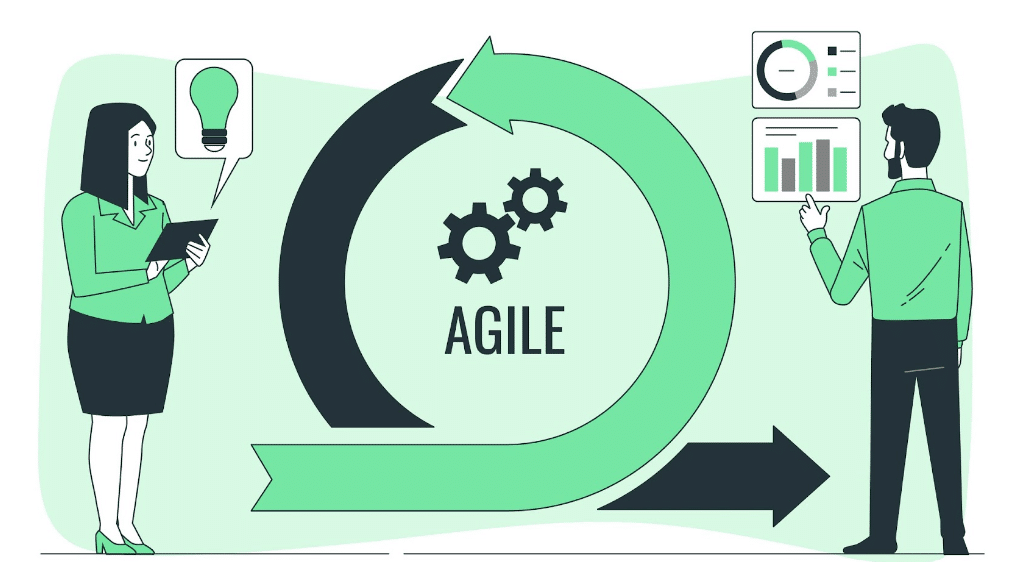Thriving in today's competitive marketplace demands agility. Businesses must adapt swiftly to evolving market conditions. Agile Development Strategies empower organizations to achieve this adaptability, catalyzing unprecedented growth. By embracing Agile methodologies, companies can streamline product development, enhance customer satisfaction, and drive a significant revenue surge. Let's explore how Agile Development Strategies revolutionize the path to business growth.
Decoding Agile Development: Principles for Progress
Agile Development is a dynamic, flexible approach to software development. Its core principles prioritize collaboration, customer feedback, and embracing change. Unlike traditional rigid models, Agile champions an iterative, incremental process. Satisfying customers through early, consistent delivery of valuable software is paramount. Accommodating changing requirements, even late in development, is embraced as a competitive edge.
Agile emphasizes simplicity and sustainable development, encouraging teams to maintain a steady pace, and pursue excellence through technical advancement and design. Collaboration among motivated individuals is fundamental, with face-to-face communication prioritized for efficient information exchange. By adhering to these principles, Agile Development aims not only to deliver high-quality products but also cultivate continuous improvement and adaptability.
How Agile Boosts Business Growth
Agile Development Strategies greatly quicken product development processes. This enables companies to bring products to market faster than ever before. Achieving a faster speed to market is crucial in today's rapidly evolving business landscape. It allows firms to seize opportunities and outpace rivals. Furthermore, Agile's iterative approach ensures resources focus on features and improvements offering maximum value to the business and its customers.
Delivering highly valued features leads to more effective product offerings. This drives higher sales and fosters sustainable growth. What's more, Agile's continuous feedback loop allows businesses to iteratively refine products. Responsiveness to customer needs and market changes not only optimizes product-market fit but propels businesses forward in their growth trajectory.
Agile and Customer Satisfaction: A Winning Combo
At Agile Development Strategies' core lies deep commitment to customer satisfaction. Agile elevates customers' role in the development process. Their feedback and needs shape the product in real-time. This approach swiftly delivers features and improvements aligning closely with customer values. Agile's iterative nature allows frequent updates and enhancements. Customers sense ongoing progress and involvement. Constant engagement and ability to swiftly adapt to feedback not only meet but often exceed expectations. This solidifies trust and loyalty. Agile's transparency gives customers clearer insight into development. This enhances their connection and satisfaction. Through this responsiveness and collaboration synergy, Agile builds a robust foundation for lasting customer relationships - a key business success driver.
Good To Read :- Enterprise Software Solutions for Business Transformation
Enhancing Output and Spirit Through Agile Methods
Agile boosts team drive by sharing responsibility. Breaking projects into chunks keeps aims clear, raising production and drive. Regular reviews let teams discuss openly, find ways to progress, and bond. Daily sync-ups solidify goals and unity. This adaptable style powers productivity and good morale, growing a sense of purpose. Agile shapes an atmosphere where output and team spirit flourish.
Integrating Agile Company-Wide for Peak Value
For max Agile impact, spread its practices throughout the business. Don't just implement methods superficially; instill Agile culture deeply across all departments like marketing, HR, and sales. This boosts the firm's agility overall, streamlining inter-departmental processes, and building cross-team rapport. An organization-wide Agile culture harmonizes components to pivot swiftly toward common growth and efficiency targets. Build cross-functional Agile-driven teams for innovation spanning the company. This lets businesses adapt quickly to markets, optimizing operations, fostering a cohesive Agile environment poised for expansion.
Must Read :- Best Travel Apps and Business Solutions in 2024
Integrating Agile Practices Effectively
Implementing Agile methodologies calls for a meticulous plan encompassing leadership backing, thorough training, and a supportive atmosphere. Leaders must go beyond endorsing Agile Development Strategies - they need to actively participate in reshaping the mindset, demonstrating commitment through decisions. This top-level engagement is essential for organization-wide adoption of Agile values.
Additionally, a structured learning program is pivotal. All team members must fully grasp Agile processes and responsibilities within this structure. Engaging Agile coaches can guide teams through the transition seamlessly, addressing obstacles, refining practices. Setting clear, measurable objectives allows tracking progress, making adjustments. This proactive approach, coupled with relentless learning and adaptation, sets the foundation for a smooth shift to Agile Development Strategies, fueling productivity and innovation.
Navigating Agile Adoption Hurdles
Transitioning to Agile Development Strategies often faces hurdles - resistance to change is a major roadblock. Resistance may stem from entrenched reliance on traditional methods, comfort with existing norms. Open communication about Agile's tangible benefits, like increased agility, quicker market responsiveness, is crucial. Tailored training demystifies Agile practices, equips teams with requisite skills and mindset. Creating an environment celebrating quick wins visibly demonstrates Agile's value, motivating further engagement. Clarifying that Agile is not one-size-fits-all, but a flexible framework adaptable to an organization's needs, is essential. Addressing these points can smooth the path to Agile adoption, overcoming initial resistance, setting the stage for sustainable success and adaptability.
Elevate your digital presence with the industry leaders in Top Software Product Development Companies in India. Request a quote now!
Wrapping up
Agile Development Strategies are a change in how work happens. They fit the needs of business today. Companies can adopt these. They move fast when markets shift. This keeps them growing and new. The core of Agile is teamwork, being flexible, and always focusing on customers. This new way pushes companies ahead. It makes products better and operations smoother. Teams are excited and get things done. Starting Agile has challenges, for sure. But the gains outweigh the troubles: competitiveness rises, growth speeds up. So Agile is worth doing. As industries evolve, the Agile principles will guide success and leadership.


No comments yet